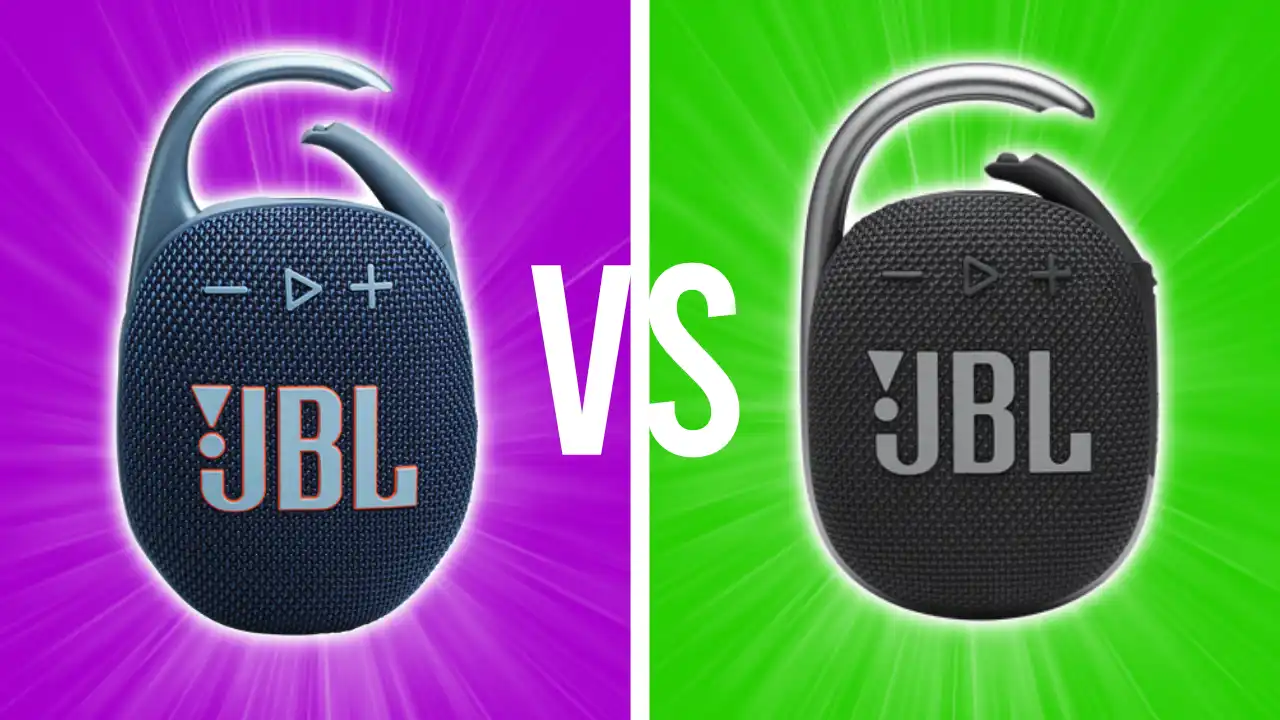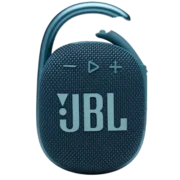

JBL Clip 5

JBL Clip 4
The Design
The JBL Clip 5 and Clip 4 look, unsurprisingly, quite similar. With the JBL logo emblazoned loud and proud across the front of each, and both also wrapped predominantly in a thick plastic speaker grille. It’s a design that’s worked well across the range of JBL’s bluetooth speakers.
Physically they are very similar in size too, with the Clip 5 being slightly taller, wider, and thicker. thatdoes equate to it weighinh 100g more than the Clip 4.
The rear of the speakers see a minor improvement. The thin rubberised strips that were glued onto the back of the Clip 4 have been replaced with fewer, and thicker, strips that are now embedded into the Clip 5.
This was a needed upgrade as the rubberized strips on the Clip 4 do come off over time. I’ve owned a JBL Clip 4 for 2 years and most of the rubberised strips have come off as the glue seems to degrade over time. So, JBL seem to be aware of the issue as the redesign should make the grip strips more resistant to wear and tear, although only time will tell with that.
Both have an integrated carabiner design that allows each speaker to hang off pretty much anything. However, the carabiner on the JBL Clip 5 has been redesigned, giving it a wider opening and flatter design. This allows the Clip 5 to clip onto things that the Clip 4 just can’t. The carabiner on the Clip 4 does go all around the outside of the speaker though, which does offer it some more protection from accidental drops.
Controls
The physical controls on both speakers are very similar with buttons for power on/off, bluetooth pairing, and volume and playback control. Whilst the playback button on both speakers allow you to play and pause your music, as well as skip a track forwards, the Clip 5 adds to that with a triple press of the play button letting you skip a track back as well.
Weatherproof
Both speakers are IP67 rated, making them not only dust proof but water resistant as well. So if either get dropped into a pool, or you’re taking them down the beach, you don’t have to worry about them.
Battery Life
Whilst the JBL Clip 4 had a good 10 hours of battery life on a full charge, the Clip 5 improves on that with 12 hours of battery life. You can get an extra 3 hours of battery life on the Clip 5 if you enable it’s ‘play boost’ function. However, all that really does is change the EQ of the speaker to consume less power. It massively drops the bass to this and has such a detrimental effect on the sound quality that I wouldn’t recommend using it. Even without it, it’s still got 2 hours better battery life than the older Clip 4.
When you do need to charge either, they both come with USB-C ports and take around 3 hours to fully charge.
The Sound
The JBL Clip 4 has a frequency range of 100 Hz to 20 kHz and provides 5 watts of power. The JBL Clip 5 improves on this by supporting a frequency range of 95 Hz to 20 kHz, and is also 40% louder, providing 7 watts of power.
So whilst the Clip 4 can easily go loud enough to fill a small room, the Clip 5 definitely goes louder.
There’s also more bass in the Clip 5 than the Clip 4. So that extra low-end frequency support definitely helps. The Clip 5 also had more presence in the treble, but the mids on the Clip 4 were clearer.
The achilles heal for the JBL CLip 4 though is it’s lack of mobile app support. So you are stuck with how the Clip 4 sounds. However, JBL has added mobile app support to the JBL Clip 5. So if you don’t like quite how it sounds you can jump into the app and change it to a number of different presets, or jump into the five-band graphic equalizer and customise it yourself. The app also allows the JBL Clip 5 to get firmware updates. So as JBL hopefully improves this speaker over time it’s just going to sound even better.
Pairing
So the JBL Clip 4 is very much a stand alone speaker. There’s no mobile app support, or support for JBL’s Partyboost feature which allows most of their speakers to pair with each other.
However, the JBL Clip 5 is very much a part of the new JBL range of speakers as not only does it have mobile app support but it can also be paired with another Clip 5 for stereo sound.
Not only that but the JBL Clip 5 also supports Auracast. This is a new Bluetooth standard that allows any Auracast compatible devices to connect to each other. So, you can pair the JBL Clip 5 with any other Auracast compatible speaker, or a range of Auracast compatible speakers. It’s not just limited to JBL Speakers. I’ve paired these up with an Auracast pair of earbuds and have had the same music playing out of both!
It’s great to see companies moving away from proprietary systems like Partyboost and embrace more widespread common protocols. Here’s to hoping that it becomes a trend across more and more companies.
Verdict
So previously, the JBL Clip 4 was the most used speaker in my house. It was used in the shower, outside, down the beach. It went pretty much everywhere. It had good enough sound, weighed little, and so was easy to take whereever you wanted to go.
The JBL Clip 5 just takes everything that was great about the Clip 4 and improves it. Wider, bigger, louder, sound. More battery life. Mobile app support. Auracast support. All that for the same $80 that the JBL Clip 4 cost when it was released. That makes the JBL Clip 5 a great choice if you’re looking for a lightweight, portable, good sounding, speaker.
However, you now pick up the Clip 4 for as little as $50, and it is still a great little speaker. So if you don’t mind missing out on a few features, and want to save some money, then the Clip 4 is still a good buy.
If you’ve got the JBL Clip 4 then I’d only really recommend upgrading if you really want the extra features of the Clip 5.


